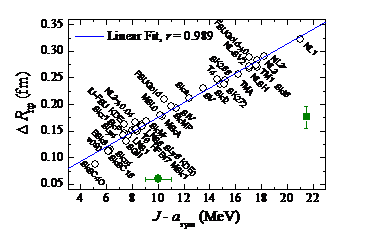The researchers in the Theoretical Physics Group at Institute of Modern Physics (IMP), Chinese Academy of Sciences,have investigated the neutron skin thickness in 208Pb with a more practicable strategy.
Accurate knowledge about the neutron skin thickness in 208Pb has far-reaching implications for different communities of nuclear physics and astrophysics. It is closely related to the neutron star structure and cooling, pulsar glitch. Many measurements have been focusing on it with different methods, such as exotic atoms, pygmy dipole resonance, proton elastic scattering, proton inelastic scattering and electron dipole polarizability. However, systematic uncertainties associated with various model assumptions are unavoidable in these mentioned approaches. The novel parity-violating electron elastic scattering experiment (PREX) recently has been suggested as a model-independent probe to the neutron skin thickness, whereas it may yield a result carrying a large uncertainty.
In the present work, the researchers have introduced a practicable strategy (namely, J-asym) to constrain the neutron skin thickness, as shown in Fig. 1, which turns out to be more effective than the parity-violating asymmetry APV in the current PREX. The J-asym(A) can be well determined based onthe researchers’ previous work (PRC 88 (2013) 014302; PRC 89 (2014) 017305) thanks to a wealth of the measured data on nuclear masses and on beta decay energies. Compared with the parity-violating asymmetry APV in the PREX, the reliably experimental information on the J-asym is much more easily available attributed to the experimentally measured data on nuclear masses and on decay energies. On the other hand, to reach the same error level of the neutron skin thickness ΔRnp, say, ±0.021 fm, the J -asym with 20% accuracy is accurate enough, whereas the APV in the PREX should be measured at least up to 2% accuracy. Thus, it is indicated that the J-asym is currently a much more effective probe to the ΔRnp compared with the APV in the PREX. The ΔRnp of 208Pb is calculated to be 0.176 ± 0.021 fm in the present work. This result is expected to be significantly meaningful to discriminate between the models and predictions relevant for the description of nuclear properties and neutron stars.
The reseachers proposed for a new method (or concept) in nuclear physics called ‘tomoscan’ to grasp richer information on the neutron skin thickness ΔRnp,and based on this method, the following conclusion has been obtained :
1. To obtain the ΔRnp, one simply needs to measure the nucleon densities in 208Pb from Rm = 7.61 ± 0.04 fm and the densities in the range of r < Rm have no contribution to the ΔRnp. Thus, the measurement on the ΔRnp could be significantly simplified in the hadron scattering experiments.
2. It has been widely believed that the nuclear surface structure is well constrained in nuclear energy-density functionals, while in experimental measurements the interior profile is ambiguous. However, the researchers have showed that it is not justified. To grasp the ΔRnp, one must especially concentrate on the dilute matter located in nuclear surface which results in the dominant uncertainty. Moreover, this method could also be used to explore other intriguing issues, such as the halo structure in exotic nuclei.
In the present work, the density dependence of the symmetry energy at subsaturation and suprasaturation densities has also been constrained with the J-asym. With the derived values of the J-asym, the density dependence of the symmetry energy near the saturation density, is constrained well, particularly the slope parameter L at ρ=0.11fm-3 (the correlation coefficient is up to 0.995). The obtained results can be applied to explore some intriguing problems in nuclear astrophysics and have important impacts on its relevant problems. For example, the transition density from a solid neutron star crust to the liquid interior is estimated to be 0.091±0.008 fm−3.
The work has been published in Phys. Rev. C 91, 034315 (2015).
The article can be linked as follows:
http://journals.aps.org/prc/abstract/10.1103/PhysRevC.91.034315

Fig. 1. Neutron skin thickness ΔRnp in 208Pb against the J − asym with different nuclear energy-density functionals.

